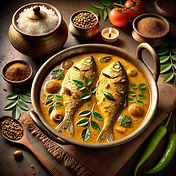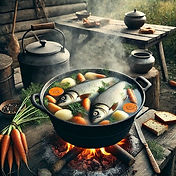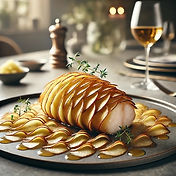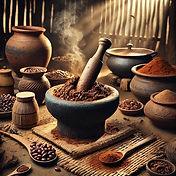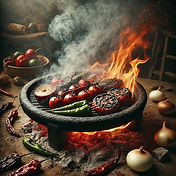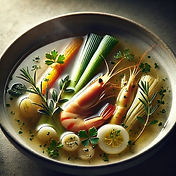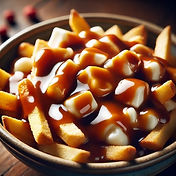Top Chef ™: World All-Stars
Season:
Week:
Elimination Challenge

The chefs cooked rice dishes for the judges and 100 guests at Alexandra Palace. The guest judge was Top Chef ™ South Africa host Lorna Maseko.
Padma Lakshi: "After 19 seasons of Top Chef, no ingredient has caused more chefs to pack their knives than risotto rice. Rice is a staple food around the world. From pulau to paella to tadig, rice dishes can be vastly different depending on where you're from. Rice can be quite temperamental.
You need to get the ratio between rice and water perfectly. For your elimination challenge, we want a rice dish. How you'd like to prepare it is up to you. Sweet, savory, or if you are daring, a risotto. But you should know you'll be cooking your rice dish for 100 guests at Alexandra palace. We're putting you, chefs, to the test. Remember, feature the rice. "

Get recipes ...
Subscribe to our weekly recipes and culinary tips from streamed cooking shows.
Dishes prepared in
Top Chef ™: World All-Stars
Chef Dawn: " I made a black Venus congee with a black bean and five-spice braised oxtail."
Chef May: "My mom and my grandma made this dessert for me as a rice pudding dessert with watermelon puffed rice and sweet potato."
Chef Gabri: "I made a green risotto with mole negro. There are 54 ingredients in that mole. The risotto is rendered green by salsa verde."
Chef Buddha: "I made Hainanese Chicken Rice, a classic Singaporean dish that my dad would teach me all the time."
Chef Victoire: "I made basmati rice with sauce maafe and vegetables and shrimp."
Chef Nicole: "My favorite japanese sushi roll is a negitoro maki. So I did a crispy furikiki rice with negitoro on top. The sauce is a pickled ginger aioli."
Chef Begona: " I'm doing seaweed rice. Not many people choose it. I love the flavor. I will use canaroli rice, and I will cook it with pickled ginger, beetroot and seaweed. I want to use the skin from the lemon. It will make a kind of risotto."
Chef Sylwia: "My dish is going to be jasmine coconut rice, inspired by the thai dish masamam curry. The potatoes get the taste of the massaman, and that will complement rice. I'm not a big fan of rice. I'm potato girl. And at the last minute I decided to put some vanilla salt on the top - it's a bit risky, but I want to showcase the different flavors with rice."
Chef Dale: "I'm going to make congee with short ribs. I've never made congee before, but I've had it. My cooks make it all the time for staff meals, so I'm going to do that. I think because the fact that congee is essentially overcooked rice, I feel reasonably comfortable. I go with Koshihikari rice, which is like a sushi rice."
Chef Sara: "I'm doing sticky rice, but I'm going to put a bunch of "everything spice" in there, and then I'm going to crisp it up on the plancha to end up like a cracker ... and serve it with salmon, cucumber and cream cheese. It's a play on The Everything Bagel."
Chef Amar: "I'm making a pomegranate beef stew with a saffron aroncini and a herbed yoghurt sauce - Fesanjan style. Aroncini is the leftover risotto you shape into a little bowl. You bread it, you deep fry it. I'm using arborio rice."
Chef Tom: " Every culture in the world uses rice ... except the Germans. So for this challenge, I'm making a Sri Lankan version of Lamb Biryani. My colleagues on the cruise ship, they're Indians. So we use this a lot for family meals, and it means something to me. I'm serving the biryani with a fermented and pickled raisin and goji berry salad."
Chef Dawn: "The challenge with oxtail is to get them tender in the time provided. I need pressure cookers!"
Culinary Challenges inspired by
Top Chef ™: World All-Stars
Meen Moilee is a celebrated Kerala fish curry that exemplifies South Indian coastal cuisine. This luxurious dish features firm white fish gently poached in a velvety coconut milk sauce infused with aromatic spices. The preparation begins by sautéing curry leaves, green chilies, ginger, and onions until fragrant, then adding turmeric, ground spices, and coconut milk to create a golden, creamy base. The fish is carefully added last, allowing it to cook just until tender. The hallmark of Meen Moilee is its balanced flavor profile - mild heat complemented by tanginess from tomatoes or sometimes vinegar, sweetness from coconut milk, and brightness from fresh lime juice. Served with rice, this curry represents the perfect harmony of Kerala's abundant seafood and tropical ingredients.
Ukha is a traditional Russian clear fish broth that dates back centuries, revered for its clean, delicate flavors. This aromatic soup begins by gently simmering whole fish—typically freshwater varieties like pike, perch, or sturgeon—with minimal vegetables and aromatics, allowing the pure essence of the fish to shine through.
The preparation is deliberately simple: fish, onions, carrots, bay leaves, black peppercorns, and occasionally potatoes or leeks. What distinguishes ukha is its clarity—the broth should remain transparent, never cloudy. Often finished with fresh herbs like dill or parsley and a splash of vodka, authentic ukha embodies Russian cuisine's philosophy of highlighting natural flavors rather than masking them with excessive seasonings.
Pommes de terre en écailles, meaning "scaly potatoes" in French, is an elegant potato preparation technique that transforms the humble tuber into a sophisticated side dish. Thin-sliced rounds of peeled potatoes are meticulously arranged in overlapping patterns resembling fish scales or roof tiles in a buttered dish. Each layer is brushed with melted butter and seasoned with salt and pepper before the next is added. The assembled potatoes are then baked until the edges turn wonderfully crisp while the centers remain tender.
The result is a visually striking dish with beautiful textural contrast—crispy, golden exterior scales protecting creamy interiors—that elevates any meal with its refined presentation and rich buttery flavor.
Dawadawa is a traditional West African fermented seasoning made primarily from locust beans (Parkia biglobosa), though occasionally from soybeans or other legumes. The preparation begins by boiling the beans until soft, then pounding them to remove the seed coats. The cleaned seeds are boiled again, spread out, and covered with leaves to ferment naturally for 2-3 days. This fermentation process develops a pungent aroma and complex, umami-rich flavor profile. The resulting black paste is typically shaped into balls or patties for storage. Used as a flavor foundation in soups, stews, and sauces across Ghana, Nigeria, and other West African countries, dawadawa adds remarkable depth and nutritional value to countless dishes.
You can buy dawadawa spice here.
Pipian is a rich, traditional Mexican sauce that exemplifies the complexity of pre-Hispanic cuisine. Made from ground pumpkin or squash seeds (pepitas), this velvety sauce incorporates various chiles, spices, and sometimes nuts or seeds like sesame or peanuts. The ingredients are toasted, ground into a paste, and simmered with broth until thickened to a smooth consistency. Pipian can range from vibrant green (pipian verde) to deep red (pipian rojo), depending on the chiles used. Commonly served over poultry or pork, this sauce offers a nutty, earthy flavor profile with subtle heat that showcases Mexico's remarkable ability to balance complex flavors into harmonious dishes.
Tatemado is a traditional Mexican cooking technique most commonly associated with Jalisco cuisine. This slow-cooking method involves placing ingredients—typically meat such as pork, goat, or beef—into clay pots that are partially buried in hot coals or placed in an underground pit oven. The pots are sealed with masa (corn dough) to trap moisture and smoke, allowing the meat to cook gently for several hours until incredibly tender. This process imparts a distinctive earthy flavor while preserving the meat's natural juices.
Tatemado dishes are often seasoned with regional spices, chiles, and herbs, creating complex flavor profiles that showcase Mexico's rich culinary heritage. The result is meltingly tender meat with unparalleled depth of flavor.
Nage, pronounced "nahj," is a fragrant, aromatic broth used in French cuisine primarily for poaching seafood and vegetables. This delicate liquid is typically created by simmering wine, water, or fish stock with aromatic vegetables (onions, celery, fennel) and herbs. After cooking, the ingredients may be strained out, and the remaining liquid can be reduced and enriched with butter to create a "beurre monté" sauce.
The term 'nage' is also used to describe dishes cooked in this liquid—referred to as "à la nage"—resulting in light, flavorful preparations that highlight the natural taste of the main ingredient while infusing it with subtle complexity.
Poutine: Quebec's Beloved Comfort Food
Poutine is a Canadian culinary treasure originating from Quebec in the late 1950s. This hearty dish consists of three essential components: crispy french fries, cheese curds, and rich brown gravy poured generously over the top, creating a delicious mess of contrasting textures and flavors.
The magic of poutine lies in its seemingly simple yet perfectly balanced combination. When done right, the fries remain crisp on the outside while soaking up savory gravy. The cheese curds, which must be fresh to achieve their signature 'squeak' between your teeth, soften slightly from the heat without fully melting. The gravy ties everything together with its savory depth. It is basically a roux, traditionally thickened with chicken or beef stock but a vegetarian option is just as good, with flavor from umami-rich mushrooms or earthy beets.
To create authentic poutine at home, begin with freshly cut potatoes, twice-fried for optimal crispness - first at a lower temperature to cook through, then at a higher temperature for that golden exterior. The cheese curds should be room temperature and as fresh as possible. Their slightly tangy flavor and distinctive texture cannot be substituted with shredded cheese. For the gravy, create a flavorful stock reduction, thickened to a consistency that coats the back of a spoon without being gloopy.
Assembly requires careful timing. The fries must be piping hot from the fryer, immediately topped with curds and quickly covered with steaming gravy that's hot enough to warm the curds but not so hot it melts them completely.
While traditional poutine remains a beloved classic, modern variations might include toppings like pulled pork, smoked meat, or even lobster. Whether enjoyed from a roadside stand in rural Quebec or prepared in your kitchen, poutine represents comfort food at its finest. it is unpretentious, indulgent, and deeply satisfying.
Soba Cha (also known as Soba-Cha and Sobacha) is Japanese buckwheat tea. It is drunk hot or cold, and is gluten-free and caffeine-free and apparently tastes nutty and slightly sweet.
It appeared three times in Top Chef: Wisconsin ™. The first showing was in Restaurant Wars when Danny's team, under his leadership, served up cold Soba Cha as a welcome drink. It wasn't well received.
In reparation, Danny re-introduced it in week 12 when he infused mushrooms into Soba Cha for his fish dish. This time, the judges regretted that he had buried the flavor of the buckwheat tea in very powerful mushroom flavors and would have preferred the essence of the tea to shine through.
Danny didn't try again, but Dan used Soba Cha in his Smoked Dashi and this time it went down a storm.
Hummingbird cake is a Jamaican banana and pineapple spiced cake which has been eaten in the southern United States since the 1970s. It is a leavened cake with a salty cake and often contains pecans.
Mofongo is a Caribbean dish originating in Puerto Rico and the Dominican Republic. Made by mashing ripe plantains with fat, garlic, spices, and (optionally) pork crackling, it is then shaped into a ball. The dish is famous for its complex and contrasting textures, with fried plantains that are crispy on the outside and soft on the inside. It is often found topped with melted cheese and served with a clear garlic broth.
Danny, in the 'spoiler' for the Top Chef Wisconsin Finale, was heard to say that he wanted to get fresh scallops for his first course and treat them in the style of "Leche de Tigre".
Leche de tigre, (translates to tiger's milk), is the Peruvian term for a citrus marinade that cures fish or seafood. Also known as leche de pantera, this marinade usually contains lime juice, onion, chile, and fish sauce.















